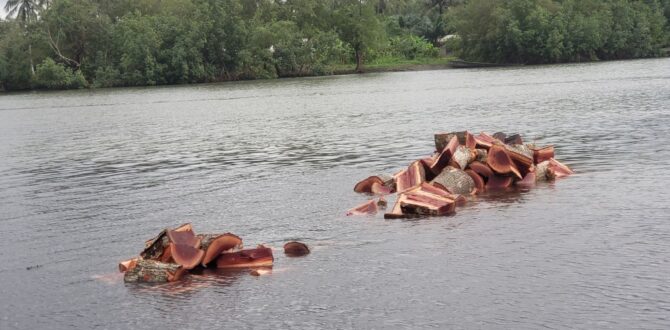By Ndimuh B. Shancho
_____________________
At the foot of Mount Cameroon, along the Cameroon Atlantic Coast of the West African Gulf of Guinea; lies the Tiko Mangrove, a wetland of international importance, according to Ramsar Convention criteria, and a home to many amphibians, reptiles, fishes, water birds and other biodiversity species. Despite being one of Cameroon’s best weapons to fight against climate change, a home to species, a veritable source of income to residents, and the fact that Cameroon is signatory to the Ramsar Convention, the mangrove of this area is still being depleted at a disturbing rate. Statistics from Open Data for Environment and Civic Awareness (ODECA) in 2022 indicates that at least 234 tons of mangroves are harvested per month from the Tiko Creek.

The Avion Beach is one of the popular beaches in Tiko known for the buying and selling of mangroves. On this Saturday morning, at about 10 am, Mr. Shey Timothy and his friends, who declined to give their names to “strangers”, are busy splitting mangroves. We could count at least 10 piles of split mangroves awaiting customers.
As my colleague and I lifted our eyes towards the river, we saw a canoe hauling logs of mangrove towards the shore. Without waiting for us to ask, Mr. Shey Timothy, who is one of the coordinators of the Matanda Warriors (mangrove harvesters) at the Avion Beach said: “In this beach, we have six boats, but we use two boats daily to exploit these mangroves. As you can see, this is the first boat coming to drop the mangrove that has been cut and after one hour thirty minutes, the second boat will come.”
Mangrove Marketing Chain
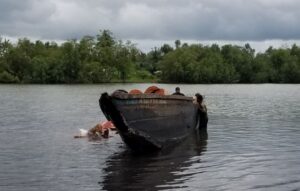
The Avion Beach mangrove harvesters Coordinator describes the harvesting, marketing and consumption chain; “we go as far as Douala, cut the woods and haul with canoes to the beach where our customers, mostly from Tiko and neighboring villages, come and buy for cooking, fish smoking and for their bakery.” In the course of our discussion, a truck, with the capacity of carrying up to three tons of mangroves drove into the Beach, and the matanda warriors started loading it. Mr. Shey notices the shock in our eyes and immediately comes in: “We usually have up to three of them here every day, alongside taxis”.
The Matanda Warriors believe that the mangrove in their community is God’s gift to salvage them from unemployment and poverty. “God gave these gifts to us in Tiko so that we will not suffer. Every communities have their own gift from God; the people of Limbe and Idenau have fish, while those in Mungo have sand,” they noted.
Moving along the Avion, not even one mature mangrove could be spotted. The mangrove harvesters said they are aware of the consequences of their activities, and have been taking measures to ensure sustainability. “We have reduced the number of canoes for hauling of logs from three and four to just two per day, and have resorted to harvesting only mature mangroves for smaller ones to grow,” the Coordinator of mangrove harvesters at the Avion Beach disclosed. He pleads with the Cameroon government to set up companies and create employment opportunities that can take them off the mangroves for a more effective restoration.
A Cameroon-based biodiversity conservation and sustainable development non-profit organization, Voice of Nature (VoNat), believes that the key to the short and long term conservation of the Tiko Mangroves is in the hands of kids and young adults., who are mostly left out of mangrove conservation initiatives. In June 2023, the organization leveraged the support of British Ecological Society to empower and engage 30 kids and young adults from Tiko.
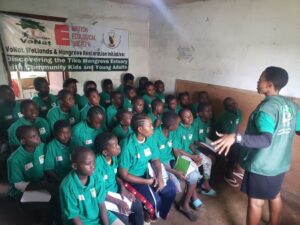
VoNat enlightened the future conservation leaders about the Tiko Mangroves, and its conservation importance, before taking them in to the mangrove estuary to discover the biodiversity species therein and conservation threats. Using mobile apps, the 30 youngsters made 30 observations with up to 15 species identified including amphibians species, fish, reptiles, crabs and other species.
“I saw different types of crabs, frogs, snails, and fish living in the area which I do not know their names yet. All the mangroves here are young and serving as home to these living things,” Makoukang Elvera Marissa from Upper Costain community said. She expressed love for the mangroves, promising to share her love for mangroves with her friends and families and the need for conservation.
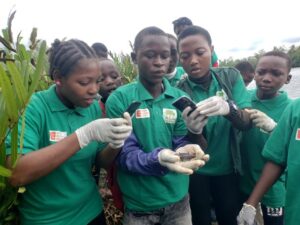
Kids Put on the Frontline
The education and ecological study sessions ignite fresh love for mangroves in the kids and youth. The youngsters are guided by the VoNat technical team to translate their love for mangroves and discoveries at the Tiko Mangrove Estuary into media arts tools like songs, poems, articles, drama, drawings etc. They are using these media arts tools to raise awareness and enhance the understanding of local communities in the Tiko Mangrove Area of Cameroon on the need to conserve and restore the Tiko Mangrove estuary in an outreach and community-wide education and sensitization campaign.
They are able to reach out to hundreds community members in Tiko and other parts of Cameroon with mangrove conservation messages and a call to action using micro radio programmes, door-to-door sensitization and a public event.
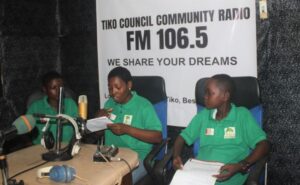
“We are telling our friends, families and community members that mangroves play a great role in absorbing the carbon dioxide in the atmosphere that is causing climate change, protects us against floods and strong winds, serve as habitant for species living in the water including the fish that we eat every day. They should join us in conserving mangroves by not cutting them down and polluting the ecosystem,” says Arrah Tracy, one of the participating children, during a public outreach and sensitization programme.
These messages are weaved into songs, a drama, poems, drawings, articles and stories for continuous education and sensitization about the conservation of the Tiko Mangroves.
Local Leaders Respond
Local leaders and community members have not remained indifferent to the mangrove conservation messages. The Divisional Officer of Tiko Subdivision, Von Buikame Kawa Amstrong, says “the mangroves and our environment as a whole has to be protected. I am happy that young people like you are coming up with such an initiative. You have all my support.”
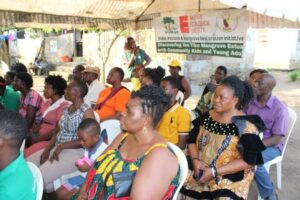
Mrs. Tiku Magdalene Angwo, a Tiko based mother, says; “these children have taught us a lot. I agree with them that we need to conserve the Tiko mangroves for posterity”. The Chairman of Upper Costain Community, Mr. Cletus Dinghkaa expresses satisfaction with the mangrove conservation lessons learnt. “We are loaded with knowledge about the mangroves; how to preserve and conserve them and how important they are to us,” he attests.
With more and more conservation consciousness being generated within communities in Tiko about mangrove conservation, there is an urgent need to assess and provide alternative sustainability schemes to mangrove harvesters, to divert their attention from depleting the emblematic ecosystem, while engaging them in restoration actions. There is also need for more hands-on conservation actions with the community kids and youths to sustain the new-found mangrove conservation zeal in the young conservation ambassadors.

